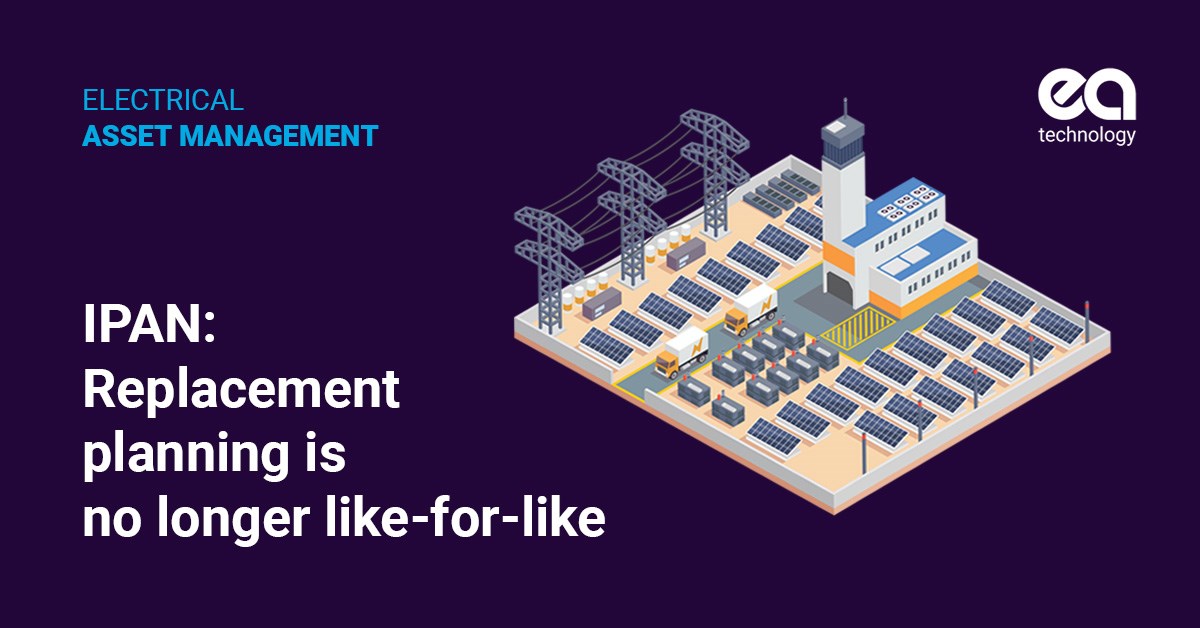IPAN – Replacement planning is no longer like-for-like
-
09 August 2023
-
EA Technology

The Industry Practice Application Note (IPAN) for Replacement Planning goes a lot further than suggesting that asset replacement planners should be using an asset health and risk valuation framework to quantify the economic benefits of asset replacement or refurbishment.
The AER outlines eight core principles for asset planners:
- Alignment with the NEO, the NER, and good industry practice.
- Service requirements vary over time and cannot be known with certainty.
- The asset’s service cost varies over time.
- Technical end-of-life is a trigger for assessing the prudent response.
- Economic end-of-life must be demonstrated for asset retirement.
- The need to de-rate an asset may arise from technical and economic sources.
- Options analysis should be comprehensive and robust.
- Flexibility, small scale actions, and deferral have economic ‘option’ value.
Principle one establishes the need for replacement planning guidelines. It highlights the rules and why good planning principles should be applied to replacement, operational and retirement decisions. Spoiler: it’s all about price, quality, safety and reliability and security of supply.
Principle two let’s network service providers know it’s okay to make mistakes when estimating and that service levels themselves may vary over time. Distributed generation is specifically mentioned here and planners are urged to consider future networks and the impact over time.
Principles three through five outline the requirements for calculation of asset health, residual life, likelihood of failure, consequences of failure and risk. The document also outlines why these metrics are important and how they can be used to support asset replacement decisions.
Principle six introduces the concept of de-rating or decommissioning end of service life assets. The AER is concerned that like-for-like replacement may result in stranded assets and misallocated capital and resources. If the energy is being delivered by consumers at the low voltage end of the network, substation capacity at current levels may not be required.
Principle seven should be no stranger to traditional capacity planners, who routinely investigate a range of equivalent options, including non-network options, to meet network limitations. Again, this is simply good planning practice, but does require detailed network modelling of the type that used be applied mainly to capacity driven work. Load flow analysis, load forecasting and detailed network analysis leading to consideration of capacity constraints. Non-network options could consist of load curtailment or generation to meet peak demand. Traditionally this has been from large customers but DER may mean that residential customers, via a VPP, could act as the generator.
Principle eight urges planners to consider least regret or low capital cost options. Uncertainty around future networks creates additional risk for malinvestment. The IPAN urges planners to quantify the risks associated with large investment decisions and incorporate that into the options analysis.
Conclusion
The IPAN urges asset managers and planners to consider many factors when an asset may be nearing the end of its service life.
- Has the asset reached end of life?
- Is it becoming more expensive to maintain and operate?
- Is it likely to fail in service?
- What are the consequences of an in service failure?
- Is the full capacity of the asset still required?
- Could the asset be de-loaded, de-rated or decommissioned?
- What is the impact of embedded generation and storage on the network being supported by the asset?
- Has a detailed network study been conducted including the effects of DER?
- Have least regret, low capital cost and non-network options been considered?
- Has an options analysis been conducted incorporating all of the above?
The days of like-for-like replacement planning are indeed over.
Related blogs:

Get in touch
Thank you for your interest in EA Technology. You can request information or a free callback by clicking the link below. One of our experts will be in touch with you shortly.